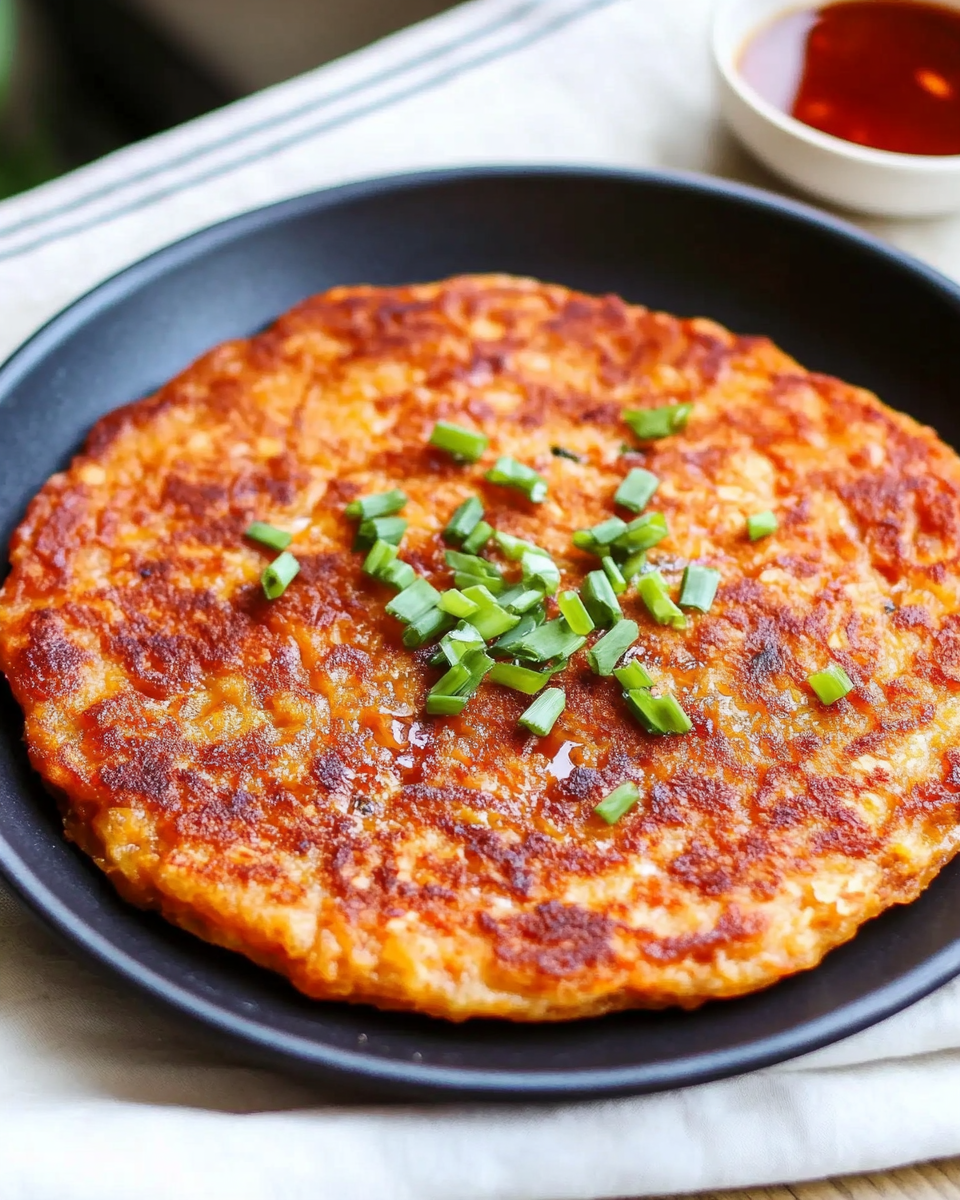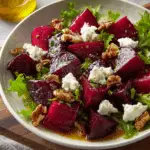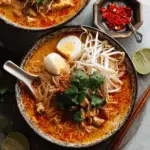The irresistible sizzle of this Kimchijeon will make your kitchen smell like a cozy Korean eatery. Made with aged kimchi, tuna, and fresh aromatics, this crispy pancake is packed with umami and comes together in just minutes. Each golden slice offers a perfect balance of spice, tang, and crunch.
Ideal for a quick appetizer, brunch, or satisfying meal, this savory pancake is as flexible as it is flavorful. Whether you enjoy it on its own or paired with a dipping sauce, it’s a comforting dish that brings traditional Korean flavors straight to your table with minimal effort.
Full recipe:
Ingredients:
-
3/4 cup all-purpose flour
-
1 tsp sugar
-
1/2 tsp salt
-
1/2-1 tbsp Gochugaru (Korean chili flakes), adjust to taste
-
1/4 cup kimchi brine (juice from fermented kimchi)
-
2/3 cup ice-cold water
-
1 large egg (optional)
-
1 cup aged kimchi, sliced (about 200g)
-
1 can tuna, drained (198g) – or substitute with veggies, seafood, or meat
-
1/4 medium onion, diced
-
1 green onion, chopped
-
2 tbsp neutral oil for frying
Directions:
-
In a medium bowl, combine flour, sugar, salt, Gochugaru, kimchi brine, water, and egg (if using). Mix until smooth.
-
Stir in the sliced kimchi, tuna, diced onion, and green onion.
-
Heat a non-stick skillet over medium heat and add oil.
-
Pour the batter into the skillet and spread it evenly with a spoon or ladle.
-
Cook for 2-3 minutes until golden brown on the bottom and easily movable in the pan.
-
Flip the pancake carefully, adding more oil around the edges, and press it down slightly.
-
Cook until both sides are crisp and golden.
-
Serve immediately, optionally with a soy-vinegar dipping sauce.
Prep Time: 10 minutes | Cooking Time: 5 minutes | Total Time: 15 minutes
Kcal: 407 kcal | Servings: 2 servings
Cultural Significance of Kimchijeon
In Korean cuisine, “jeon” refers to a wide category of pan-fried dishes made by mixing ingredients with flour and egg, then frying them into golden brown pancakes. Kimchijeon is a standout among them due to its reliance on aged kimchi—an ingredient central to Korean identity and culinary tradition. This pancake is more than just a way to use up old kimchi; it’s a celebration of fermentation, bold seasoning, and home-style cooking. Many families enjoy it on rainy days, and the sizzling sound of the pancake cooking is said to mimic the soothing sound of raindrops.
Kimchijeon is also a popular dish during Korean holidays like Chuseok (Korean Thanksgiving) or Seollal (Lunar New Year), when jeon is served in generous platters alongside other varieties such as seafood (haemul jeon), mung bean (bindaetteok), and meat-based pancakes. Its versatility and strong flavor make it a favorite choice for these occasions.
Why Aged Kimchi Matters
The use of aged or fermented kimchi is crucial in making a flavorful Kimchijeon. As kimchi ferments over time, it becomes tangier, more pungent, and richer in umami. This depth of flavor is what gives Kimchijeon its signature taste. Using freshly made kimchi would not yield the same intensity, as the sugars in unfermented or lightly fermented cabbage have not yet converted into the acids and enzymes that create that bold, sour kick.
To expedite the fermentation process, many cooks leave kimchi out at room temperature overnight before making the pancake. This step ensures that even store-bought kimchi can develop deeper complexity and contribute more dramatically to the flavor of the final dish.
Customizations and Variations
One of the most appealing aspects of Kimchijeon is its flexibility. While the classic recipe uses aged kimchi and sometimes canned tuna for added protein and umami, it’s easy to personalize this dish based on what you have on hand. Some popular variations include:
-
Vegetarian Kimchijeon: Simply omit the tuna or meat and add more vegetables such as mushrooms, zucchini, or carrots.
-
Seafood Kimchijeon: Add shrimp, calamari, or clams for a briny seafood flavor that pairs well with the spicy kimchi.
-
Cheese Kimchijeon: A fusion twist that includes shredded mozzarella or cheddar cheese melted on top or mixed into the batter.
-
Pork Kimchijeon: Finely chopped pork belly or ground pork can be added for a richer, meatier version.
The batter is also versatile. While traditional recipes call for wheat flour, some home cooks use rice flour or Korean pancake mix (buchimgaru) for a different texture—crispier or chewier depending on the flour type.
Flavor Profile and Texture
Kimchijeon is a flavor bomb. Each bite is packed with the fermented tang of kimchi, the mild heat of gochugaru (Korean chili flakes), and the savoriness of tuna or meat if added. The onion and green onion add aromatics and texture, while the flour and water create a batter that fries into a crispy yet slightly chewy pancake.
What makes Kimchijeon so addictive is the contrast between textures: the crunch from the pan-fried surface and the softness inside. The outer layer crisps up beautifully in oil, while the interior remains moist and savory. The optional dipping sauce—often made with soy sauce, vinegar, sugar, and a pinch of chili—adds a salty-tangy kick that complements the pancake’s richness.
When and How to Serve Kimchijeon
Kimchijeon is incredibly versatile in terms of serving occasions. It’s a popular choice for:
-
Quick meals or snacks: Takes less than 15 minutes to prepare from start to finish.
-
Side dishes (banchan): Complements a Korean meal with rice, soup, and several banchan.
-
Brunch menus: Great alternative to Western pancakes or omelets.
-
Rainy days or cold weather: Offers comforting warmth and robust flavors.
-
Entertaining guests: Easy to scale up for a crowd and can be sliced into bite-sized pieces.
It’s best served hot, straight from the pan, but leftovers reheat well in a skillet or microwave. For a more gourmet presentation, garnish with sesame seeds, chopped chives, or a dollop of sour cream or Greek yogurt for a Korean-Western fusion vibe.
Nutrition and Dietary Notes
Kimchijeon is naturally low in sugar and can be made gluten-free with rice flour or a gluten-free all-purpose blend. While the dish includes minimal oil for frying, the overall calorie count stays moderate, making it a satisfying yet relatively healthy option. One serving generally contains about 400 kcal, depending on ingredients and portion size.
If you’re watching your sodium intake, consider rinsing the kimchi slightly or using a lighter soy sauce in the dipping sauce. You can also balance out the meal with a side of steamed vegetables or a bowl of rice to tone down the saltiness.
Tips for Perfect Kimchijeon
To achieve the best results with Kimchijeon, keep the following tips in mind:
-
Use ice-cold water in the batter for maximum crispiness.
-
Don’t overcrowd the pan. A thin, evenly spread layer will cook faster and crisp better.
-
Let the batter rest for 5 minutes before frying to allow the flour to hydrate fully.
-
Press down slightly with your spatula during cooking to ensure even browning.
-
Serve immediately to enjoy the contrast of hot and crispy textures.
Pairing Suggestions
Kimchijeon is traditionally enjoyed with makgeolli, a milky Korean rice wine that balances the spicy and salty flavors of the pancake. However, it also pairs well with:
-
Light beers or lagers
-
Crisp white wines such as Riesling or Sauvignon Blanc
-
Green tea or barley tea for a non-alcoholic option
-
A bowl of Korean soup such as Doenjang Jjigae (soybean paste stew) or Kimchi Jjigae
The acidity and spice in the pancake are nicely offset by milder, cooling side dishes or beverages.
Conclusion
Kimchijeon is a true gem of Korean home cooking—quick, easy, deeply flavorful, and endlessly adaptable. With just a few pantry staples and a handful of vegetables or protein, you can create a dish that tastes like it came from a bustling street market in Seoul. Whether you’re new to Korean cuisine or a longtime fan of kimchi, this pancake deserves a permanent place in your cooking repertoire.
It’s more than just a way to use up old kimchi—it’s a cultural experience in every crispy bite. So next time you crave something spicy, crispy, and comforting, try whipping up a batch of Kimchijeon. Your taste buds will thank you.






